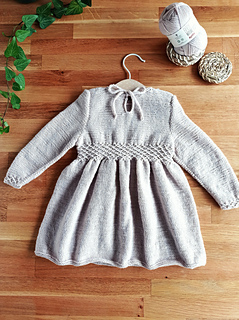patterns >  Esti Juango's Ravelry Store
Esti Juango's Ravelry Store
> Ramoni dress












Ramoni dress
Summer/ winter sweet dress for the little ones.
It is a simple, timeless dress, which connects the grandma-mother-grandchild generations.
Inspiration
When I close my eyes and come back to my childhood, I remember that bee’s nest dress my grandmother sewed for me. The waist imitates that relief of the pleated fabric of those bee’s nest dresses and also it is the transition between a stockinette st pattern and the reverse stockinette stitch pattern.
Difficulty Level
Advanced or Adventurous beginner.
Pattern has been tech edited.
Previous skills
To knit and purl, simple increase and decrease.
The skirt is knitting in the round, but can also be adapted to knit flat.
Sizes
2 (4, 6, 8, 10, 12) years old.
Material
- Yarn: Drops Merino Extra fine – 50gr; Each skein has 115 yds/105 m. Merino Superwash Wool (100%)
- Two colors with sleeves: Color A (pink): 200 (250, 300, 350, 400, 450) gr. Total in m: 420 (525, 630, 735, 840, 945) Total in yds: 460 (575, 690, 805, 920, 1.035) Color B (white): 100 (150, 200, 200, 250, 300) gr. Total in m: 210 (315, 420, 420, 525, 630) Total in yds: 230 (345, 460, 460, 575, 690)
- One color: 300 (400, 450, 550, 650, 700) gr. Total in m: 630 (840, 945, 1.155, 1.365, 1.470) Total in yds: 690 (920, 1.035, 1.265, 1.495, 1.610)
- Circular needles 4 mm (US 6) with 50cm/ 20 in or 75 cm/30 in cables
- Auxiliary or Cable needle
- Markers
- Waste yarn or stitch holders
- Tapestry needle
Gauge
In a 10x10 cm (4 in 4 in) square you should have 20 sts and 27 rows. Knit the swatch with stockinette stitch and block it.
Construction notes
The dress is worked bottom up. The skirt is knitted in the round. After completing the skirt we work the waist in “bee’s nest” stitch. We continue working in the round until reaching the armhole. Work flat for the front and back. Shoulder seam is invisible with Kitchener stitch. For the back opening and neck work an i-cord bind off.
Instructions provided also for the sleeveless dress.
------Español/ Spanish----
Inspiración
Cuando cierro los ojos y vuelvo a mi infancia, recuerdo el vestido blanco de nido de abeja que me cosió mi abuela. La cintura imita ese relieve y fruncido de la tela y sirve para pasar de un punto jersey del derecho en la falda, a un punto jersey del revés de la parte superior. Pretende ser un vestido sencillo y atemporal, que une los diseños de generaciones de abuelas y nietas.
Mis hijas se están vistiendo con mucha ropa que su bisabuela tejió para su nieto.
Nivel de Dificultad
Principiante - intermedio
El patrón ha sido editado técnicamente.
Requisitos previos:
Saber tejer derecho, revés, hacer aumentos y disminuciones simples.
Aunque puede hacerse en plano, la falda está planteada para que sea tejida en circular
Tallas:
2 (4, 6, 8, 10, 12) años
Materiales
- Lana: Drops Merino Extra fine – 50gr; 105m (115yds). Merino Superwash Wool (100%)
Tienes la opción de hacerlo en dos colores o en uno únicamente.
- Si usas dos colores:
Color A (rosa): 200 (250, 300, 350, 400, 450) gr.
Total en m: 420 (525, 630, 735, 840, 945)
Color B (blanco): 100 (150, 200, 200, 250, 300) gr.
Total en m: 210 (315, 420, 420, 525, 630)
- Si usas un único color:
300 (400, 450, 550, 650, 700) gr.
Total en m: 630 (840, 945, 1.155, 1.365, 1.470)
- Aguja circular de 4 mm (US6) con cable de 50 o 75 cm según tu preferencia
- Marcadores
- Aguja auxiliar
- Imperdible o hilo adicional para dejar p en espera
- Aguja lanera para coser
Tejido de Muestra
Trabaja la muestra en punto jersey. Deberás obtener 20p por 27 pas con una aguja de 4 mm en un cuadrado tejido de 10x10 cm. Bloquea la muestra antes de tomar las medidas.
Notas de construcción
El vestido está tejido de abajo hacia arriba. Toda la falda y cintura está tejida en circular. Una vez tejida la cintura en “nido de abeja” se teje de ida y vuelta el delantero y luego el trasero. La costura del hombro es invisible, cosida en punto jersey con la costura Kitchener.
La apertura trasera está rematada con un i-cord que permite cerrar el vestido con un lazo.
Instrucciones también disponibles para vestido sin mangas.
44880 projects
stashed
21445 times
- First published: March 2022
- Page created: April 8, 2022
- Last updated: March 23, 2025 …
- visits in the last 24 hours
- visitors right now




